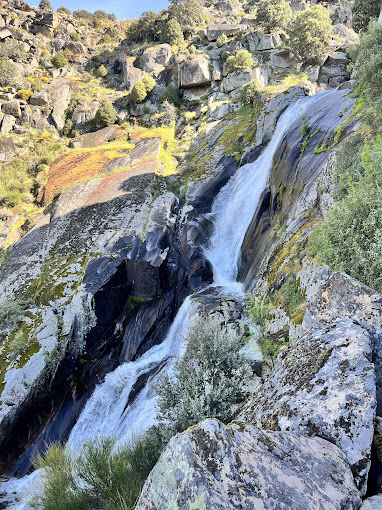Lastras de Agua Brava Waterfall: Complete Guide for Your Visit
Discover the impressive Lastras de Agua Brava Waterfall in Zamora. Learn how to get to this natural paradise!
If you love nature and are looking for a place that combines beauty, tranquillity and adventure, the Lastras de Agua Brava Waterfall is a destination you cannot miss. Located in the impressive Arribes del Duero Natural Park, this hidden gem near the small village of Mámoles will surprise you with its spectacular waterfall and dreamlike surroundings.

Source: Raúl Jiménez Díaz via Google Maps
Where is the Lastras de Agua Brava Waterfall located?
The Lastras de Agua Brava Waterfall is located within the Arribes del Duero Natural Park. This park is known for its stunning landscapes, where the River Duero has carved out deep canyons and waterfalls over the centuries. The waterfall is located near the small town of Mámoles, a picturesque village that preserves the essence of rural Spain.
How to get to the waterfall?
To get there, you will first have to drive to Mámoles, and from there, a beautiful hiking trail will take you directly to this natural paradise.
From Zamora
From Zamora, the most common route is to take the CL-527 road to Bermillo de Sayago and then continue on the ZA-304 to Fariza. From Fariza, a local road will take you to Mámoles in approximately seven minutes. Although the road is narrow and can be in variable condition, the journey offers enchanting views of the Sayago landscape.
From Fermoselle
If you are staying at the Posada Doña Urraca in Fermoselle, the best route is to take the ZA-316 road towards Fornillos de Fermoselle and then join the ZA-324 towards Fariza. From this point, follow the local road to Mámoles. This journey takes approximately 25 minutes and offers a panoramic route through the heart of the Arribes del Duero, with views of the river canyons and the unique terrain of the Sayago region.
Last section: Hiking trail from Mámoles
Once in Mámoles, leave your car near the village church and get ready for a walk of about 5.4 km (round trip). The trail is well marked and will take you through meadows, rocky areas and small streams. It is not a difficult route, but we recommend wearing comfortable footwear as there are some uneven areas.

Source: Carmen Julián via Google Maps
As you walk, you will enjoy a landscape where green fields and granite rock combine with the sound of water flowing in the distance. And when you arrive, the reward is unique: the roar of falling water, the coolness of the atmosphere and a perfect postcard for your memories (and your photos).
What makes this waterfall so special?
The Lastras de Agua Brava Waterfall has a drop of about 15 metres, formed by the action of water filtering through granite rocks. If you visit between November and May, you will see it in all its splendour thanks to the rains and snowmelt. In summer, although the flow is lower, the place still has a special charm.
But it's not just the waterfall that will leave you speechless. This corner of the world is home to an impressive biodiversity. You can see birds of prey such as golden eagles and griffon vultures, and with a bit of luck, even the elusive black stork. Otters swim stealthily in the nearby streams, adding to the magic of the place.

Source: Rulle Alonso via Google Maps
Geology and landscape formation
The landscape of Arribes del Duero has been shaped over millions of years by the erosive action of the River Duero, which has carved deep canyons and valleys into the granite rock that predominates in the area. The waterfall emerges in a section where fractures in the granite have facilitated water filtration, forming a spectacular drop of approximately 15 metres in height. During the rainy season and snowmelt, the flow increases considerably, offering an impressive sight.
Flora and fauna
The area around the waterfall is home to a wide variety of wildlife. The vegetation includes riverside species such as alders, ash trees and willows, which provide shelter for numerous animal species. In terms of fauna, the park is an important habitat for birds of prey, including golden eagles, Egyptian vultures, peregrine falcons and griffon vultures. It is also possible to spot the elusive black stork, a protected species that nests on the cliffs of the Duero. In addition, the waters of the river and nearby streams are home to otters, a mammal that plays a key role in the ecological balance of the park.
Nearby viewpoints: Mirador del Testero del Burro
In addition to the waterfall itself, one of the most recommended attractions is the Mirador del Testero del Burro, a privileged spot from which you can enjoy spectacular views of the River Duero nestled in its deep granite gorge. This viewpoint is perfect for bird watching and landscape photography.
Activities you can do at the Lastras de Agua Brava Waterfall
Hiking
The route to the waterfall is ideal for hiking enthusiasts. The trail, which is low-medium difficulty, allows you to enjoy the local landscape, flora and fauna.

Source : Carmen Julián via Google Maps
Photography
The rock formations, waterfall and views from the viewpoint offer exceptional opportunities for landscape and nature photography.
Birdwatching
The area is home to various species of birds, including birds of prey, making it an ideal spot for birdwatching.
Essential tips for your visit to the Lastras de Agua Brava Waterfall
- Appropriate clothing and footwear: It is advisable to wear comfortable clothing and hiking boots, as the terrain can be uneven and, in wet weather, slippery.
- Water and food: Bring enough water and some light food, especially if you plan to spend several hours in the area.
- Sun protection and insect repellent: Depending on the time of year, it is advisable to bring sunscreen and insect repellent.
- Respect for the environment: Follow the conservation rules of the nature reserve. Do not leave rubbish behind, respect the flora and fauna, and stay on the marked trails.
Reviews and experiences of visitors to the Lastras de Agua Brava Waterfall
Many visitors highlight the beauty and tranquillity of the place. Frequent comments include surprise at discovering such a spectacular and little-known spot, as well as satisfaction at completing a route that combines nature, landscape and cultural heritage. The opportunity to observe birds in their natural habitat and the panoramic views from the viewpoint are highly valued by those who have walked this trail.
Where to stay and eat near the Lastras de Agua Brava Waterfall
Para quienes deseen prolongar su estancia y explorar más a fondo la comarca de Sayago y de los Arribes del Duero, existen diversas opciones de alojamiento y restauración en la zona. La Posada Doña Urraca, ubicada en Fermoselle, es una excelente elección.
Este alojamiento combina el encanto rural con las comodidades modernas, ofreciendo a los huéspedes una experiencia auténtica en un entorno histórico. Además, su restaurante destaca por la gastronomía local, permitiendo degustar platos tradicionales elaborados con productos de la región.
¿Merece la pena visitar la Cascada de las Lastras de Agua Brava? Nuestra opinión
For those who wish to extend their stay and explore the region of Sayago and Arribes del Duero in more depth, there are various accommodation and dining options in the area. The Posada Doña Urraca, located in Fermoselle, is an excellent choice.
This accommodation combines rural charm with modern comforts, offering guests an authentic experience in a historic setting. In addition, its restaurant is renowned for its local cuisine, allowing guests to sample traditional dishes made with regional products.
Would you like to visit it?
If you have already been to the Lastras de Agua Brava Waterfall, tell us about your experience in the comments. We would love to hear your opinion! And if you haven't visited it yet, what are you waiting for? Plan your getaway and enjoy this unique corner of Zamora.
Frequently asked questions about the waterfall
Is there an entrance fee to visit the waterfall?
No, access to the waterfall is free.
Is there parking available in Mámoles?
Yes, there are a few areas in Mámoles where you can park your car, especially near the village church. However, space is limited, so it is advisable to arrive early, especially in high season.ta.
Is the route suitable for children or elderly people?
The route to the waterfall is low to moderate in difficulty. Children can do it without any problems, although supervision is recommended in some of the more uneven areas. For elderly people or those with reduced mobility, the walk can be somewhat demanding due to the slope and rocky terrain.
When is the best time of year to visit the waterfall?
You can visit it at any time of year, but the best time to visit is between November and May, when the flow is most abundant. In summer, the water flow may be lower, which reduces the visual impact of the waterfall.

